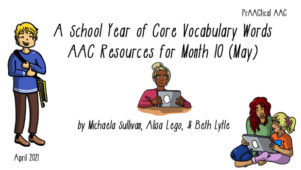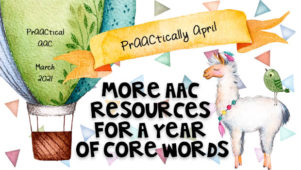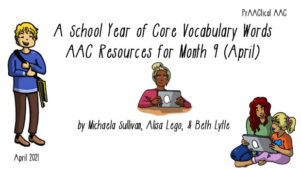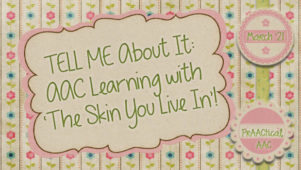Strategy of the Month: Thoughts on Teaching Core Vocabulary

Teaching new words is something SLPs plan for in almost every service delivery setting. This month, we’ll focus on vocabulary instruction for core and extended vocabulary.
Thoughts on Teaching Core Vocabulary
In Advance
- Plan ahead. Make a rough plan of the core words you will teach and when you will introduce them to the AAC learner. Make sure there is plenty of variety, especially pronouns, verbs, prepositions, conjunctions, and determiners. Words for talking about time (e.g., now, later), asking questions (e.g., what, where), and negation (e.g., not) are important, too. Here’s a link to our post on A Year of Core and A Year of Core, Unity Style.
- Ensure that the AAC learner has access to communication aids with an adequate base of core vocabulary. What if the learner doesn’t have an SGD or AAC app that is core language based? If you can update that to something with good core vocabulary, great! If not, round out the AAC system with no tech AAC, such as core language boards with flip-style vocabulary at the top, bottom, sides, or all three.
- Look at the learner’s AAC display and where the upcoming core words are located. If some of the new words are masked or hidden, consider revealing them now.
- Try to use it before you teach it. Planning to introduce 8 new words next month? Prime the learner by beginning to use them now. Use aided language input whenever you can. The more that the learner sees you using them, the stronger the foundation for language learning.
- Work with others to prepare them as well. Can the aide begin modeling the upcoming words? Many families will want to do that as well.
Teaching New Core Words
- Beef up the aided language input on the target words. Remember, the rest of the team AND the learner take their cues from us. If it isn’t important for US to use whenever we speak to the learner, then why would anyone else bother? If we want others to model AAC more often, then WE have to model AAC more often.
- Make goals explicit. Consider telling the learner what words are the target for the session, week, or month. Provide visual supports, like lists or charts, to remind everyone what our focus is. You can download ours here or make one of your own.

- Look at the symbols for the words you are teaching. Think about how to help the AAC learners make the connection between symbol and referent. It can be tough to do that when working with someone who has significant receptive language difficulties, but give it a try. Talk about the aspects of the picture symbol that are salient and give meaning.
- Teach the word in a meaningful context. Language Experience Activities are fun and memorable, but it can be challenging to come up with different activities for some of the core words we are teaching. It’s pretty easy to think up language experiences for words like ‘go’ and ‘hot,’ but trickier for words like ‘later’ and ‘have.’ Finding ways to make the meaning of those concepts and words salient takes a bit of thought and creativity.
- Supplement the contextually-based word instruction with fluency practice. We can boost their skills by eliciting productions of the new word in all sorts of ways. It’s fun to
 do this in informal interactions (e.g., “JoJo, tell Ms. Alex our new word, ‘not.’” “Eliana, I want to hear one of our new words.” “Mr. P, have you heard our Wednesday word? Tell him, Margeaux.”) because it gives the learners practice and raises awareness of others in the environment. We can also plan specific activities to get more frequent word productions. Make a Bingo or Lotto game of the core words, and have everyone say the words they look for them. Hide some core words and go on a scavenger hunt to find (and say) them.
do this in informal interactions (e.g., “JoJo, tell Ms. Alex our new word, ‘not.’” “Eliana, I want to hear one of our new words.” “Mr. P, have you heard our Wednesday word? Tell him, Margeaux.”) because it gives the learners practice and raises awareness of others in the environment. We can also plan specific activities to get more frequent word productions. Make a Bingo or Lotto game of the core words, and have everyone say the words they look for them. Hide some core words and go on a scavenger hunt to find (and say) them. - Deepen their understanding of core words by making collages of things that represent or are associated with the word. Take a stack of pictures and sort them: YES (the picture goes with our word) and NO (doesn’t belong with our word).
- Increase word consciousness by having the learners listen for the core words. Kids love to ‘catch’ us doing something! Empower them by appointing a Word Detective or deputizing some Word Police. Our AAC learners get so excited when they hear us use those words that they don’t even realize that they are shoring up their semantic foundation.
- Probe their understanding periodically, but focus the vast majority of your time on instruction and practice. Use the data to re-teach when necessary or boost opportunities for practice.
- Don’t let the concept of mastery slow down the intervention process. Learning to use core words is not like learning to cross the street. We’re looking for progress, not perfection. It is perfectly fine to move on to new words before the AAC learner uses them spontaneously or
 demonstrates consistent knowledge of them. Do you use the Cycles Approach for phonological disorders? It’s a similar concept. We move on after a period of intervention without the expectation that the learner has full mastery.
demonstrates consistent knowledge of them. Do you use the Cycles Approach for phonological disorders? It’s a similar concept. We move on after a period of intervention without the expectation that the learner has full mastery.
Moving On
- As you introduce the next set of words, don’t leave old words behind. Continue to use them when speaking, provide aided language input, and elicit them frequently (even if you have to provide help).
- Consider making a bulletin board of the core words you are teaching, and add to it over time. It’s a great way to remind the interventionists and the learners what words we should be saying. Don’t have room for a real bulletin board? Make a portable one out of trifold foam core (think Science Fair) or even a file folder.
- Make the progress visible. Use lists, graphs, or visual aids to show what words have covered.
- Track use of core words. If you made a bulletin board with core words, you can use that to mark each time you hear a learner use their new words.
Do you have fun and/or effective ways of teaching core words? We’d love to hear about them.
Filed under: Strategy of the Month
Tagged With: core language, core vocabulary, intervention, semantics, vocabulary
This post was written by Carole Zangari




